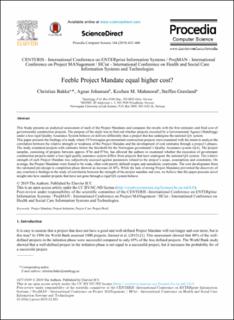| dc.contributor.author | Bakke, Christian | |
| dc.contributor.author | Johansen, Agnar | |
| dc.contributor.author | Mohammad Mahmood, Kozhen | |
| dc.contributor.author | Grenland, Steffen | |
| dc.date.accessioned | 2020-03-24T09:07:21Z | |
| dc.date.available | 2020-03-24T09:07:21Z | |
| dc.date.created | 2020-03-21T12:57:35Z | |
| dc.date.issued | 2019 | |
| dc.identifier.citation | Procedia Computer Science. 2019, 164 433-440. | en_US |
| dc.identifier.issn | 1877-0509 | |
| dc.identifier.uri | https://hdl.handle.net/11250/2648265 | |
| dc.description.abstract | This Study presents an analytical assessment of each of the Project Mandates and compares the results with the first estimates and final cost of governmental construction projects. The purpose of the study was to find out whether projects executed by a Governmental Agency (Statsbygg) under a less rigid Quality Assurance System behaves or delivers differently than a project that has undergone the national QA system.
This paper presents the findings of a study where 19 Norwegian governmental construction projects were examined with the intent to analyze the correlation between the relative strength or weakness of the Project Mandate and the development of cost estimates through a project’s phases. The study examined projects with estimates below the threshold for the Norwegian government’s Quality Assurance system (QA). The project samples, consisting of projects between approx. €7m and €75m, has allowed the authors to examined whether the execution of government construction projects under a less rigid quality assurance system differs from projects that have undergone the national QA system. The relative strength of each Project Mandate was subjectively assessed against parameters related to the project’s scope, assumptions and constraints. On average, the Project Mandates were found to be weak, often with poorly defined scopes and unrealistic constraints. The cost development from the estimated pre-design to completion phase showed an increase of 30%. While the lack of strong Project Mandates prevented the discovery of any conclusive findings in the study of correlation between the strength of the project mandate and cost, we believe that this paper presents novel insight into how smaller projects that have not gone through a rigid QA system behave. | en_US |
| dc.language.iso | eng | en_US |
| dc.publisher | Elsevier | en_US |
| dc.relation.ispartofseries | CENTERIS - International Conference on ENTERprise Information Systems / ProjMAN - International Conference on Project MANagement / HCist - International Conference on Health and Social Care Information Systems and Technologies | |
| dc.rights | CC BY-NC-ND | * |
| dc.rights.uri | http://creativecommons.org/licenses/by-nc-nd/4.0/deed.no | * |
| dc.subject | Project Mandate | en_US |
| dc.subject | Project Initiation | en_US |
| dc.subject | Project Cost | en_US |
| dc.subject | Project Brief | en_US |
| dc.title | Feeble project mandate equal higher cost? | en_US |
| dc.type | Peer reviewed | en_US |
| dc.type | Journal article | en_US |
| dc.description.version | publishedVersion | en_US |
| dc.rights.holder | © 2019 The authors | en_US |
| dc.subject.nsi | VDP::Samfunnsvitenskap: 200 | en_US |
| dc.source.pagenumber | 433-440 | en_US |
| dc.source.volume | 164 | en_US |
| dc.source.journal | Procedia Computer Science | en_US |
| dc.identifier.doi | 10.1016/j.procs.2019.12.203 | |
| dc.identifier.cristin | 1802768 | |
| cristin.ispublished | true | |
| cristin.fulltext | original | |
| cristin.qualitycode | 1 | |

